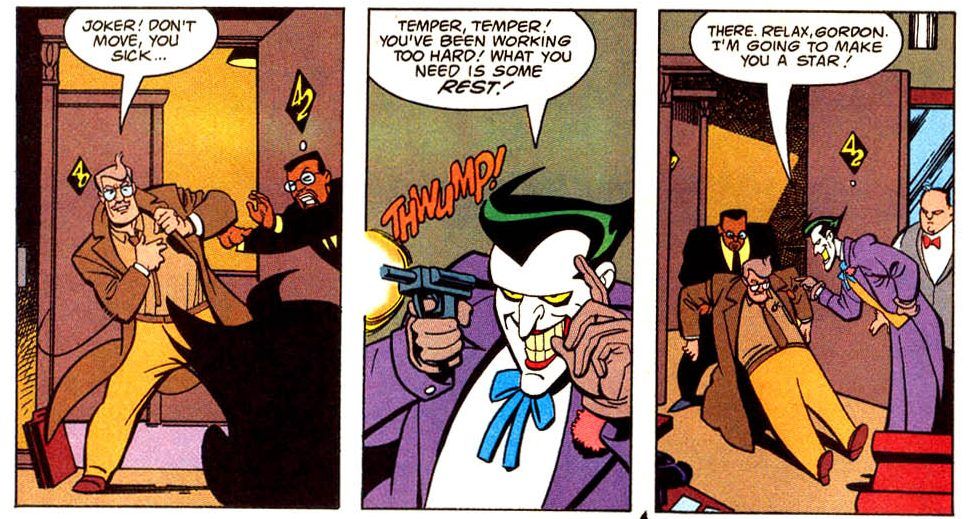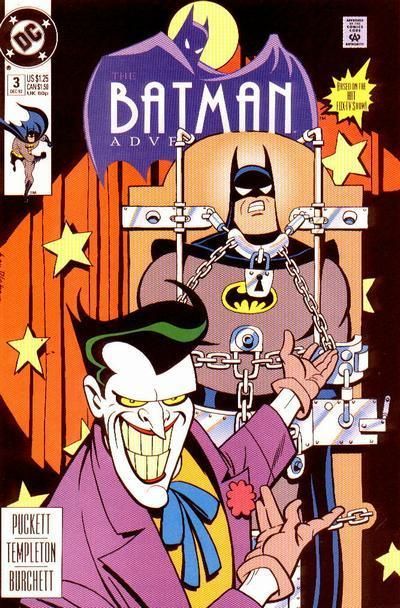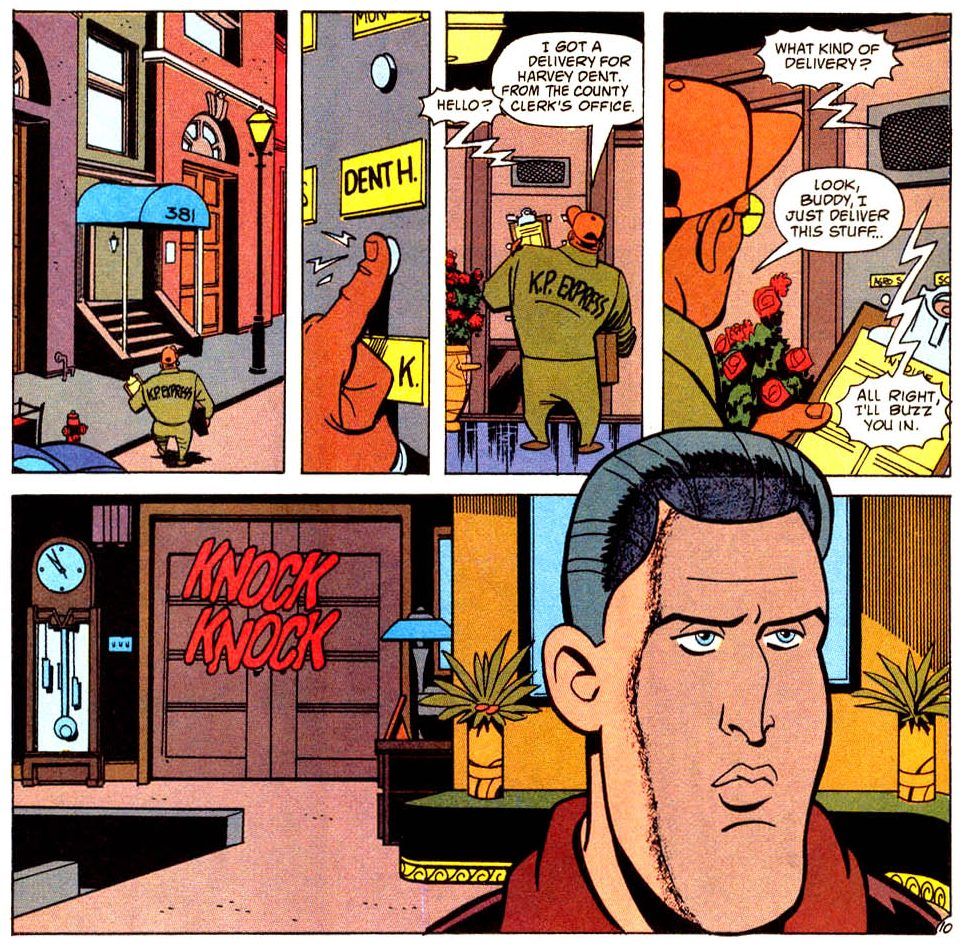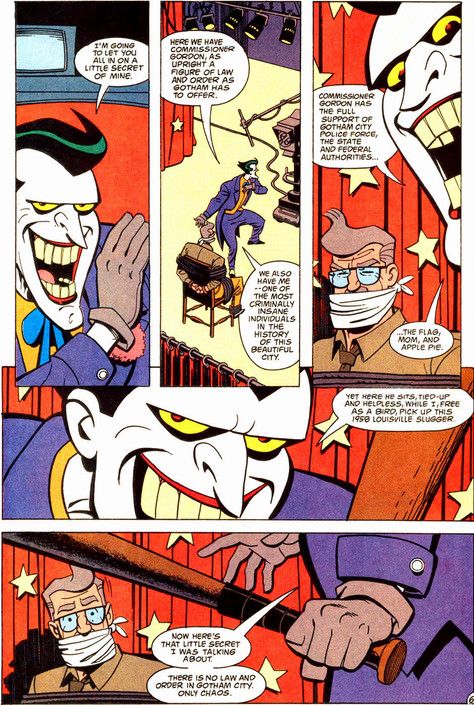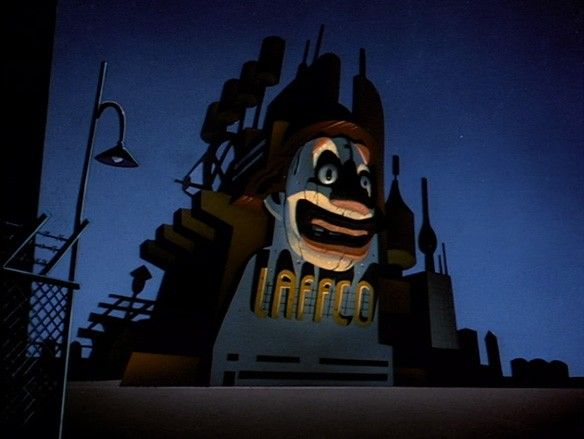Someone else on the internet discussing Batman: The Animated Series? Why not? And while we’re at it, perhaps the cult favorite Batman Adventures deserves some attention, as well. This is the first entry in a semi-regular feature called Adventure(s) Time, where I examine an episode of the animated series and an Adventures issue that shares some thematic link.
The link doesn’t have to be particularly deep -- it could be as simple as “A story that has Batgirl fighting crime while Batman’s away” or “A plot involving Harley Quinn’s attempts to upstage the Joker.” The concept of animated tie-in comics has always interested me, since the execution is more complicated than you’d might think. How does a writer avoid repeating the cartoon? How does the artist capture the look of the show? Are the writers concerned about staying loyal to the cartoon’s continuity? Who’s the audience -- kids who like the show, or the established fans who already read comics?
There’s also the subject of format -- how do the creators replicate the feel of a thirty-minute television series within the confines of a twenty-two page comic? Do the creators stick to a “done-in-one” format, or branch out and explore options not available to the animated series?
The two stories I’ve chosen today are decent examples of creators working in different formats, playing with similar ideas but executing them in varying ways. Both of these stories are from early on in the run of both the comic and the TV show, which would seem to be a logical place to start.
So, for the first entry, I’ve selected from the animated series “Christmas with the Joker” (written by Eddie Gorodetsky, a veteran sitcom writer who created the CBS series Mom, and directed by Kent Butterworth) and from the comic, issue three of Batman Adventures, “Joker’s Late-Night Lunacy!” (written by Kelly Puckett, penciled by Ty Templeton, and inked by Rick Burchett). Both stories feature the Joker making televised threats to the public, and kidnapping notable Gotham citizens for ransom...or for whatever it is the Joker wants.
We’ll begin with “Christmas with the Joker,” which is generally considered to be one of the weaker episodes of the series.
The episode opens with the Joker escaping Arkham Asylum with a rocket-powered Christmas tree, while Batman and Robin enjoy a fruitless night of searching for crimes on Christmas Eve. Batman's prepared to watch It's a Wonderful Life for the first time, thanks to Robin's prompting, when the broadcast is interrupted with the Joker, who's providing his own Christmas-themed programming for Gotham.
From there, Batman Robin chase a few red herrings, fight several giant toys, and eventually locate the Joker, who is secretly broadcasting from the abandoned headquarters of defunct toy company, Laffco, Inc. The Joker's hostages -- Commissioner Gordon, reporter Summer Gleason, and Det. (or maybe Sgt.) Bullock -- are freed, the Joker returns to Arkham, and Batman finally has a chance to catch It's a Wonderful Life. (Using Summer Gleason in this role, when practically no one watching the episode knew who she was, is a strange decision. How many of us assumed the redheaded female next to Gordon was actually Barbara?) And if it all sounds a little pat, that's because it is. To be fair, however, it's only the second episode of the series, and the show hasn't found itself yet. All of the background characters look lifted from Tiny Toons (not surprising, since the series evolved directly out of Tiny Toons), we only see a hint of the stylish art deco designs that later define the series, and many of the specific rules developed for the series aren't in place yet.
For example, the televisions in the episode are actually broadcasting in color, but every fan of the show knows that all TV broadcasts are supposed to be in black and white. Plus, the viewer has to prepare itself to hear Clive Revill as the voice Alfred, as opposed to the legendary Efrem Zimbalist, Jr. (And considering that this is the second episode, and Mark Hamill didn't come into contact with the producers until he appeared in "Heart of Ice," it's safe to assume that this is one of the Joker episodes originally voiced by Tim Curry. According to lore, the network didn't care for Curry as the Joker and Hamill was brought in to dub over his voice in the earliest episodes. Check out Curry's performance as Captain Hook in Peter Pan and the Pirates for a hint of what his Joker could've been.)
It's all okay, but it feels like standard Saturday Morning fare. The fact that the Joker can create a rocket-powered Christmas tree from within Arkham, and then wheel out a Santa-themed tank, or turn the Gotham observatory's telescope into a cannon, all with no explanation, sums up the tone of the episode perfectly. The show becomes far less gimmicky, and the mood more solemn, as the weeks develop.
“Joker’s Late-Night Lunacy!” is a tale from the earliest days of the Adventures tie-in comic; in fact, it was the intended last issue of what was thought to be a miniseries. The first three issues even form their own loose storyline, with the Joker building his own pirate television network thanks to the efforts of the Penguin and Catwoman in the first two issues. Thanks to the audience’s reaction, and the creators’ enthusiasm, Batman Adventures took on a Transformers-esque life of its own, running (in various forms) for over a hundred issues.
As editor (and future writer) Scott Peterson explains in the letter column, artist Ty Templeton penciled these issues before any episodes of the series aired; he had a brief promo reel and the model sheets to serve as his guide, and had to guess his way through the rest. Consequently, the earliest issues of the series do appear slightly off, but it’s clear that Templeton already has a decent grasp of the show. The look isn’t quite as retro-cool as the animated series, but Templeton is still drawing upon art deco influences and following the aesthetic that this reality doesn’t exist in any specific time period (an idea established by Tim Burton in the 1989 film.)
Templeton is also feeling his way through the character models, producing the occasionally wonky Joker image, but for most of the issue, playing with the cast well. The acting is particularly great this issue -- when Gordon looks on in horror as the Joker unveils his 1958 Louisville slugger, or when Batman is caught off-guard by the Joker’s tranq darts, Templeton sells the emotion perfectly. I have no idea what Templeton thought of the character models when he first saw them, but he clearly has a handle on how to make them work.
One drawing in the issue that stands out is the image of Harvey Dent on page 10 in the “Knock Knock” panel. Everyone knows that Batman: The Animated Series was heavily influenced by Jack Kirby and Alex Toth, but the John Kricfalusi inspiration is often overlooked. Bruce Timm has spoken before of his admiration for Kricfalusi as a young animator, and dang if that Harvey Dent doesn’t look like a guy who could’ve popped up on Ren & Stimpy.
Also worth noting is that Spumco animator Lynne Naylor was brought in to design Poison Ivy and provide a basis for female designs on the show. (Spumco is Kricfalusi’s studio, for those of you who weren’t around during the days of Ren & Stimpy mania.) Bruce Timm called her in after he realized that the blocky style he was developing for the show didn’t work for the female form. It’s impressive to know this show had so many diverse influences yet didn’t come out as a patchwork, instead existing as its own unique entity.
The story opens with the Joker, and his armed henchman, breaking down Commissioner Gordon’s front door and taking him hostage. The Joker is utilizing tranquilizer darts in the story, which might initially appear as a milquetoast way to follow the title’s “all ages” edict…until the story progresses and we see what the Joker’s been planning to do with Gordon all this time:
How many classic Joker bits can you fit into one scene? He’s overtaken the airwaves, kidnapped a public official, brutalized another human being, cavalierly joked about it, and given us a lecture on the nature of chaos. And he’s tossed in a nod to the Adam West series at the end, just for good measure.
From there, the issue moves on to “Act Two,” a scene that has Batman and DA Harvey Dent discussing their next move, while loudmouth Sgt. Harvey Bullock puts his own two cents in. Dividing the issues into three acts is the norm for most Adventures issues; a clear nod to the television series, which was split into three acts by the commercial breaks. To Kelly Puckett’s credit, he’s usually able to work two legitimate cliffhangers into each issue, effectively replicating the feel of watching an episode of the show. Puckett didn’t have to follow the show’s structure so religiously, but it makes for an interesting break from the standard format of a one-shot story. Puckett’s stories move quickly, hitting you with cliffhanger, cliffhanger, boom, ending, as opposed to just plodding along until he reaches page twenty-two.
One drawback of dividing the stories into three acts had to be creating a separate title for each act. Finding a good title is already hard work, but Puckett decided that he wanted four titles an issue -- one for the overall story and one for each act. How many writers would go out of their way to make their job that much more difficult?
Act Two has Harvey Dent volunteering himself as bait for the Joker, and Batman appearing just a minute too late to stop Joker and his goons from abducting Dent. There is a brief fight scene, but it’s ended abruptly when the Joker appears with his tranq gun and blasts Batman in the chest. (Hey, shouldn’t Batman have some ninja move that could block the darts? Hmm…) The cliffhanger in this act has the Joker unveiling a chained-up Batman on his pirate J-TV network. He teases the unmasking of the Batman to a horrified Gotham (although you’ve got to figure at least a few citizens want to know Batman’s secret identity).
Act Three opens with the Joker discovering, to his shock, that Batman is Harvey Dent. But…that can’t be right, because he’s already kidnapped Harvey Dent. At that moment, “Dent” breaks free of his ropes, punches out a few henchmen, and swaps his outfit with the real Dent. The Joker escapes to a nearby harbor while Batman dons the proper attire. There, we have a Batman/Joker boat chase (didn’t a later episode of the cartoon also bring us one of those?), and Batman gaining a clear victory over the Joker. Until Batman turns around and realizes that the boat is headed for the rocks. He leaps to safety and realizes that the Joker is, of course, gone. He swears he’ll get him next time, though.
So, here we have two stories with broadly similar ideas. They’re both drawing upon classic elements of the canon (the Joker overtaking the airwaves to announce his murders goes back to his first appearance, even though it was radio and not TV in those days), and working within the “continuity-light” confines of the animated world. My personal preference is for “Joker’s Late-Night Lunacy!”, which not only offers us some insight into the Joker’s motivation as a villain (while also hinting at a beating so brutal it would never appear on the show), but also uses Harvey Dent effectively as a decent civil servant and ally of Batman. Introducing Dent as the DA before going into the Two-Face storyline was one of the better decisions from the early days of the series, although I don’t think the show ever utilized him as well as Puckett does this issue.
The Wrap-Up
Design-y: Very few elements of art deco cool here, but the design for the Laffco toy factory is impressive. (“Christmas with the Joker”)
Continuity Notes: So is Harvey Bullock a detective or a sergeant in this continuity? I know that his partner Renee Montoya is promoted later, but I don't think Harvey ever gets a bump in pay grade.
I Love the ‘90s: The Joker has named his pirate TV network J-TV, complete with the slogan “I Want My J-TV!” Now, this is actually '80s instead of '90s, but MTV's original slogan remained close enough in people's memories to work as a pop culture reference. By the way, those specific pop culture references, at least ones dating past the 1950s, tend to disappear in this reality as more stories are told. (“Joker’s Late-Night Lunacy!”)
“Huh?” Moment: How could anyone mistake Harvey Dent for Batman? Not only are their physiques noticeably different, but look at those chins! You’d never get those things confused. (“Joker’s Late-Night Lunacy!”)
Battle of the Cliffhangers: Since “Christmas with the Joker” carries almost no drama with it, I'll have to cite the Joker actually taking Batman (or "Batman") captive at the end of Act Two in “Joker’s Late-Night Lunacy!" as the superior cliffhanger.
Next time…I don’t know, honestly. I’m looking for suggestions -- are there any animated episodes and Adventures comics with similar themes you’d like to see featured? Like I said in the opening, the themes could be broadly related…if there’s an Adventures issue that fleshes out Killer Croc, for example, then it would pair nicely with the “Sideshow” episode. Also, this isn’t limited to the Batman series. Any of the DC Adventures comics are fair game, and hey, I’ll even toss in those Marvel Adventures books if any of those comics follow themes similar to those seen in their animated cousins. Just let me know in the comments…
Not Blog X || Twitter || The (David) Milch Studies on Real Gentlemen of Leisure || Tumblr || Also, my novel Yeah, Shut Up. is available for whatever price you like at Noisetrade.

